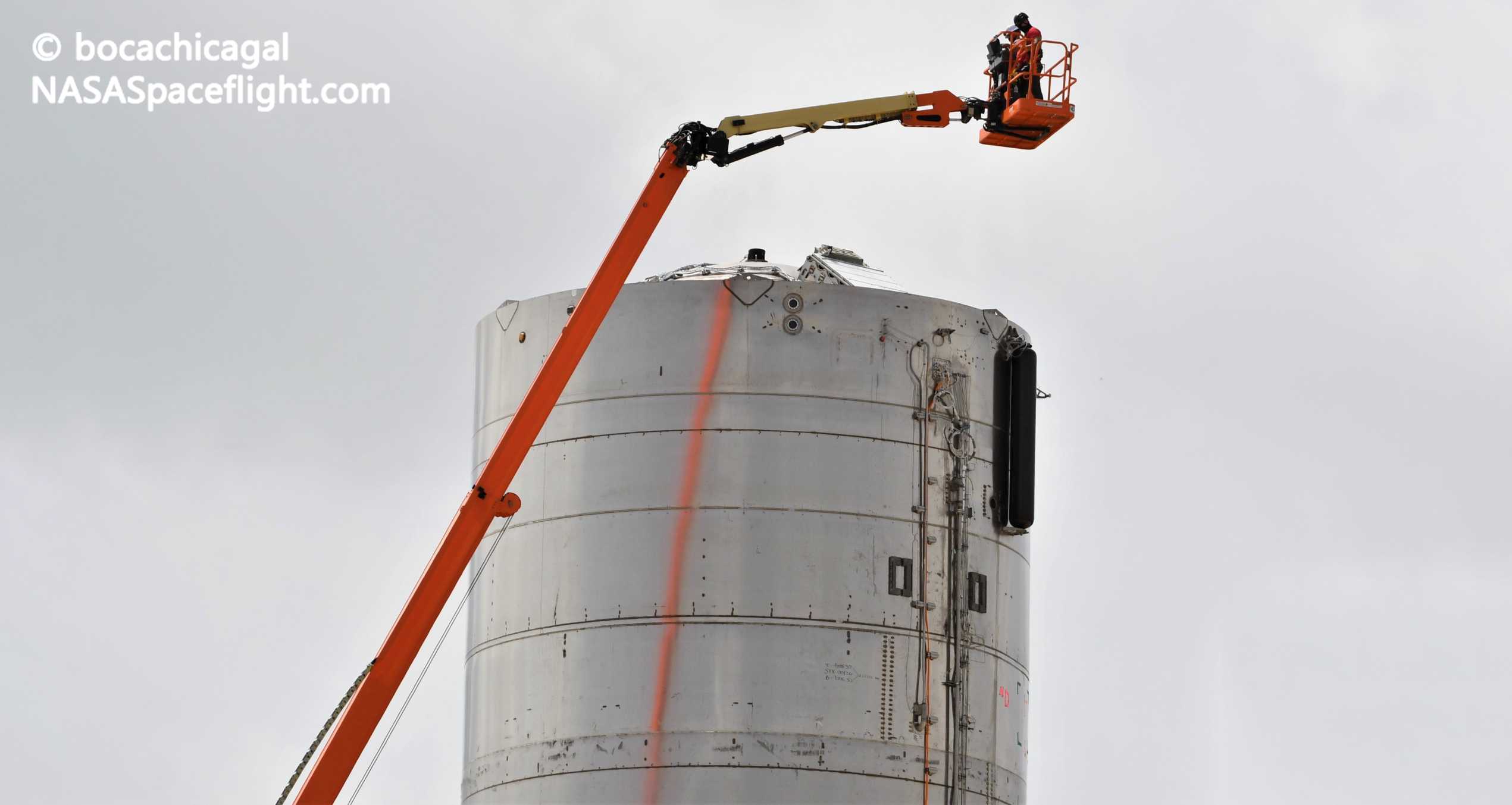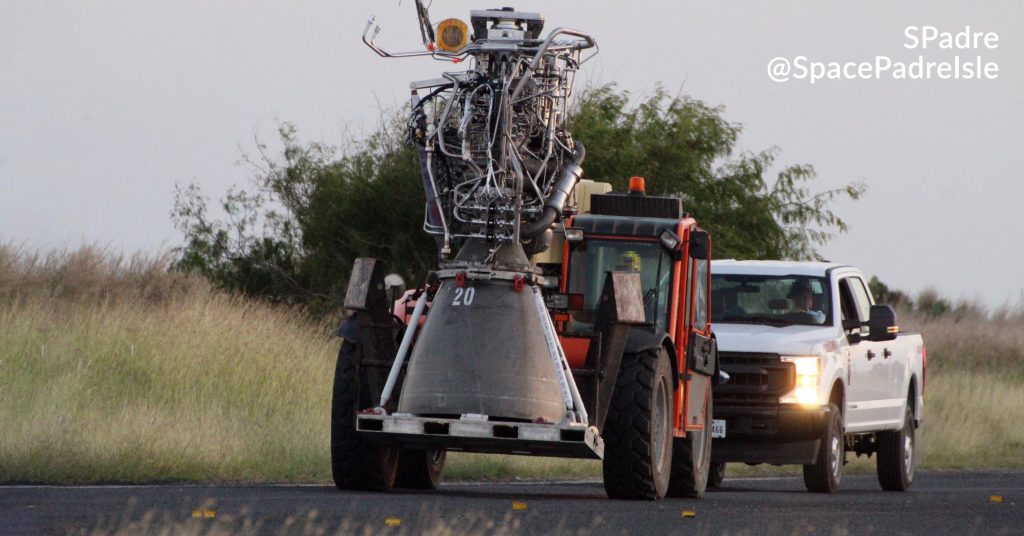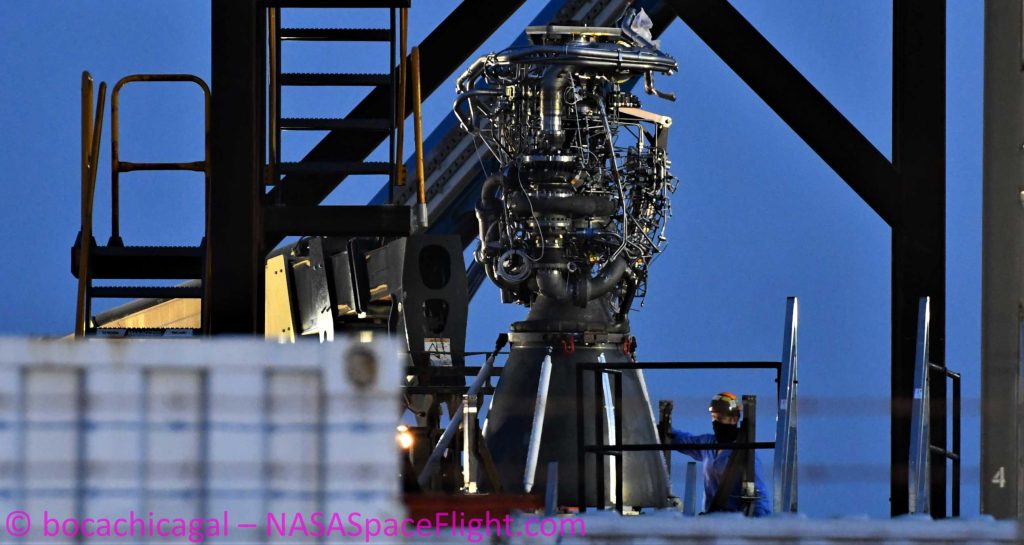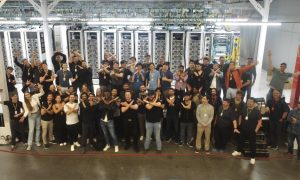

News
SpaceX Starship prototype bears down on first Raptor engine tests
SpaceX’s fifth full-scale Starship prototype is fast approaching its first Raptor static fire tests after the company recently delivered one of the newest engines to the launch site.
Known as Starship SN5, the ship is the fifth SpaceX has built since full-scale prototype development began in early 2019, as well as the fourth full-scale ship the company has completed since it began producing upgraded hardware in January 2020. SN5 rolled from SpaceX’s Boca Chica, Texas rocket factory to nearby test and launch facilities on June 24th, less than a month after Starship SN4 was destroyed by operator error minutes after completing its fourth Raptor static fire in four weeks.
While Starship SN5 was already more or less complete, SN4’s explosive demise damaged the launch mount (used to secure and fuel prototypes) beyond repair, forcing SpaceX to rapidly build and outfit a replacement. SpaceX finished that replacement mount around June 20th, installed SN5 on it a few days later, and then spent about a week finalizing and inspecting both components.
After barely a month of downtime, Starship SN5 kicked off its first gauntlet of tests late on June 30th, carrying on into the early morning of July 1st. As usual, SpaceX began with an ambient-temperature pressure test, filling Starship’s tanks with neutral nitrogen gas to check for leaks. This time around, SN5 must have been put together with exceptional care, as the company was able to immediately proceed into the ship’s first cryogenic proof test just a few hours later.
CEO Elon Musk has yet to offer any confirmation but the implication is that SN5 performed beautifully during its first liquid nitrogen proof test. Notably, based on NASASpaceflight.com’s excellent unofficial coverage, SN5’s cryo proof was uniquely ambitious. It’s unclear what if the test infrastructure, SN5, general confidence in the vehicle, or some combination of the above components were upgraded, but SpaceX appeared to load Starship SN5 with liquid nitrogen incredibly quickly, taking just 20-30 minutes to fully fuel the rocket. Given that all of that liquid nitrogen (some 1000+ metric tons or ~3.2 million gallons) is being loaded through a single “quick disconnect” panel, it’s no mean feat and far outweighs SpaceX’s already speedy Falcon 9 and Heavy propellant loading.
SpaceX is famously the only current launch vehicle operator known to “sub-cool” its rockets’ propellant, effectively squeezing a performance boost of 5-10% out of the same rocket hardware by making said propellant colder – and thus denser. That performance increase comes with tradeoffs, though, adding significantly tighter operational constraints, lowering delay tolerances, and necessitating an extremely quick propellant load. Sub-cooled liquid oxygen and methane has always been part of SpaceX’s plans for Starship, so fast-load tests were inevitable, but it’s a great sign that the company is starting to seriously think about capabilities that will be necessary for efficient orbital launches.
Meanwhile, labeled “27”, the engine – logically assumed to be Raptor SN27 – SpaceX has just installed on Starship SN5 is also of interest. On top of Musk’s recent confirmation that SpaceX is already building Raptor SN30 (probably SN31 or SN32, now), SN27’s assignment to Starship SN5 confirms that the company has managed to complete (and test) at least one next-generation engines every other week since the first full-scale engine shipped to McGregor, Texas in February 2019.


For a brand new engine as complex as Raptor, that’s an impressive production milestone. Per Musk, the end-goal is to produce at least one Raptor per day in the near term – a necessity given that each Starship and Super Heavy booster pair will require at least 37 engines. To feasibly build a fleet of tens – let alone hundreds or thousands – of Starships and boosters, one engine per day is arguably the bare minimum required just for early orbital launch attempts and initial operations.
According to published schedules, Starship SN5’s first live wet dress rehearsal (WDR) and static fire tests could happen as early July 8th, with backups on the 9th and 10th. Coincidentally, SpaceX’s next orbital Falcon 9 launch is also expected on the 8th, meaning that both Starship and Falcon 9 could fire up more or less simultaneously.
Check out Teslarati’s Marketplace! We offer Tesla accessories, including for the Tesla Cybertruck and Tesla Model 3.
News
Tesla launches in India with Model Y, showing pricing will be biggest challenge
Tesla finally got its Model Y launched in India, but it will surely come at a price for consumers.

Tesla has officially launched in India following years of delays, as it brought its Model Y to the market for the first time on Tuesday.
However, the launch showed that pricing is going to be its biggest challenge. The all-electric Model Y is priced significantly higher than in other major markets in which Tesla operates.
On Tuesday, Tesla’s Model Y went up for sale for 59,89,000 rupees for the Rear-Wheel Drive configuration, while the Long Range Rear-Wheel Drive was priced at 67,89,000.
This equates to $69,686 for the RWD and $78,994 for the Long Range RWD, a substantial markup compared to what these cars sell for in the United States.
🚨 Here’s the difference in price for the Tesla Model Y in the U.S. compared to India.
🚨 59,89,000 is $69,686
🚨 67,89,000 is $78,994 pic.twitter.com/7EUzyWLcED— TESLARATI (@Teslarati) July 15, 2025
Deliveries are currently scheduled for the third quarter, and it will be interesting to see how many units they can sell in the market at this price point.
The price includes tariffs and additional fees that are applied by the Indian government, which has aimed to work with foreign automakers to come to terms on lower duties that increase vehicle cost.
Tesla Model Y seen testing under wraps in India ahead of launch
There is a chance that these duties will be removed, which would create a more stable and affordable pricing model for Tesla in the future. President Trump and Indian Prime Minister Narendra Modi continue to iron out those details.
Maharashtra Chief Minister Devendra Fadnavis said to reporters outside the company’s new outlet in the region (via Reuters):
“In the future, we wish to see R&D and manufacturing done in India, and I am sure at an appropriate stage, Tesla will think about it.”
It appears to be eerily similar to the same “game of chicken” Tesla played with Indian government officials for the past few years. Tesla has always wanted to enter India, but was unable to do so due to these import duties.
India wanted Tesla to commit to building a Gigafactory in the country, but Tesla wanted to test demand first.
It seems this could be that demand test, and the duties are going to have a significant impact on what demand will actually be.
Elon Musk
Tesla ups Robotaxi fare price to another comical figure with service area expansion
Tesla upped its fare price for a Robotaxi ride from $4.20 to, you guessed it, $6.90.

Tesla has upped its fare price for the Robotaxi platform in Austin for the first time since its launch on June 22. The increase came on the same day that Tesla expanded its Service Area for the Robotaxi ride-hailing service, offering rides to a broader portion of the city.
The price is up from $4.20, a figure that many Tesla fans will find amusing, considering CEO Elon Musk has used that number, as well as ’69,’ as a light-hearted attempt at comedy over the past several years.
Musk confirmed yesterday that Tesla would up the price per ride from that $4.20 point to $6.90. Are we really surprised that is what the company decided on, as the expansion of the Service Area also took effect on Monday?
But the price is now a princely $6.90, as foretold in the prophecy 😂
— Elon Musk (@elonmusk) July 14, 2025
The Service Area expansion was also somewhat of a joke too, especially considering the shape of the new region where the driverless service can travel.
I wrote yesterday about how it might be funny, but in reality, it is more of a message to competitors that Tesla can expand in Austin wherever it wants at any time.
Tesla’s Robotaxi expansion wasn’t a joke, it was a warning to competitors
It was only a matter of time before the Robotaxi platform would subject riders to a higher, flat fee for a ride. This is primarily due to two reasons: the size of the access program is increasing, and, more importantly, the service area is expanding in size.
Tesla has already surpassed Waymo in Austin in terms of its service area, which is roughly five square miles larger. Waymo launched driverless rides to the public back in March, while Tesla’s just became available to a small group in June. Tesla has already expanded it, allowing new members to hail a ride from a driverless Model Y nearly every day.
The Robotaxi app is also becoming more robust as Tesla is adding new features with updates. It has already been updated on two occasions, with the most recent improvements being rolled out yesterday.
Tesla updates Robotaxi app with several big changes, including wider service area
News
Tesla Model Y and Model 3 dominate U.S. EV sales despite headwinds
Tesla’s two mainstream vehicles accounted for more than 40% of all EVs sold in the United States in Q2 2025.

Tesla’s Model Y and Model 3 remained the top-selling electric vehicles in the U.S. during Q2 2025, even as the broader EV market dipped 6.3% year-over-year.
The Model Y logged 86,120 units sold, followed by the Model 3 at 48,803. This means that Tesla’s two mainstream vehicles accounted for 43% of all EVs sold in the United States during the second quarter, as per data from Cox Automotive.
Tesla leads amid tax credit uncertainty and a tough first half
Tesla’s performance in Q2 is notable given a series of hurdles earlier in the year. The company temporarily paused Model Y deliveries in Q1 as it transitioned to the production of the new Model Y, and its retail presence was hit by protests and vandalism tied to political backlash against CEO Elon Musk. The fallout carried into Q2, yet Tesla’s two mass-market vehicles still outsold the next eight EVs combined.
Q2 marked just the third-ever YoY decline in quarterly EV sales, totaling 310,839 units. Electric vehicle sales, however, were still up 4.9% from Q1 and reached a record 607,089 units in the first half of 2025. Analysts also expect a surge in Q3 as buyers rush to qualify for federal EV tax credits before they expire on October 1, Cox Automotive noted in a post.
Legacy rivals gain ground, but Tesla holds its commanding lead
General Motors more than doubled its EV volume in the first half of 2025, selling over 78,000 units and boosting its EV market share to 12.9%. Chevrolet became the second-best-selling EV brand, pushing GM past Ford and Hyundai. Tesla, however, still retained a commanding 44.7% electric vehicle market share despite a 12% drop in in Q2 revenue, following a decline of almost 9% in Q1.
Incentives reached record highs in Q2, averaging 14.8% of transaction prices, roughly $8,500 per vehicle. As government support winds down, the used EV market is also gaining momentum, with over 100,000 used EVs sold in Q2.
Q2 2025 Kelley Blue Book EV Sales Report by Simon Alvarez on Scribd
-

 Elon Musk2 weeks ago
Elon Musk2 weeks agoTesla investors will be shocked by Jim Cramer’s latest assessment
-

 News3 days ago
News3 days agoTesla debuts hands-free Grok AI with update 2025.26: What you need to know
-

 Elon Musk1 week ago
Elon Musk1 week agoElon Musk confirms Grok 4 launch on July 9 with livestream event
-

 Elon Musk5 days ago
Elon Musk5 days agoxAI launches Grok 4 with new $300/month SuperGrok Heavy subscription
-

 News2 weeks ago
News2 weeks agoTesla Model 3 ranks as the safest new car in Europe for 2025, per Euro NCAP tests
-

 Elon Musk2 weeks ago
Elon Musk2 weeks agoxAI’s Memphis data center receives air permit despite community criticism
-

 News5 days ago
News5 days agoTesla begins Robotaxi certification push in Arizona: report
-

 Elon Musk2 weeks ago
Elon Musk2 weeks agoTesla scrambles after Musk sidekick exit, CEO takes over sales















